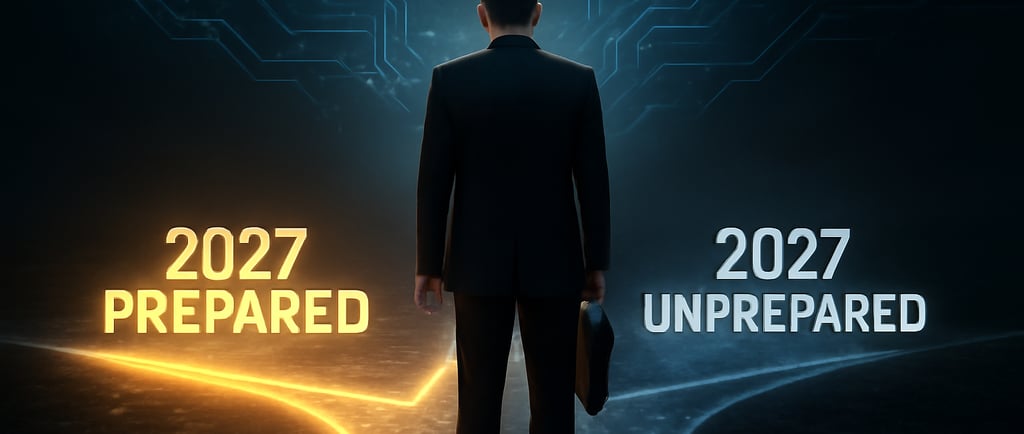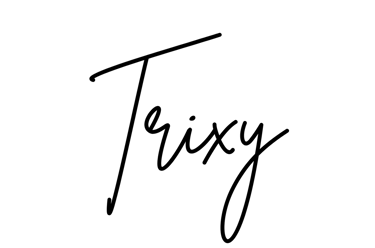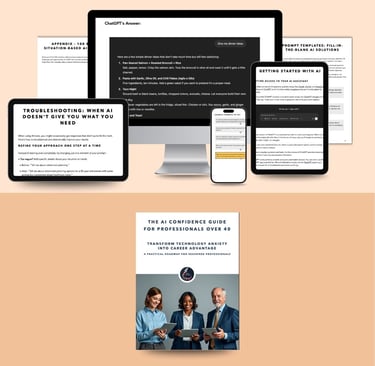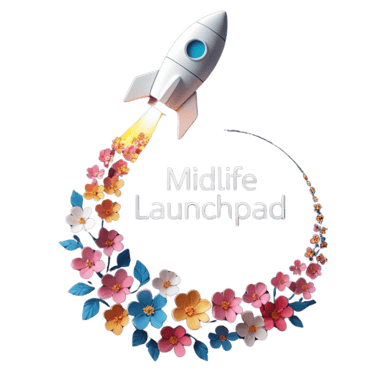Midlife Professionals: This 2027 AI Timeline Demands Action Now!
AI MASTERY FOR MIDLIFE PROFESSIONALS
Trixy
6/30/20256 min read


If you think you have time to prepare for the AI revolution, think again.
A team of AI experts led by former OpenAI researcher Daniel Kokotajlo has released the most detailed prediction of AI's near future, and it's arriving faster than anyone expected.
Their forecast shows superhuman AI emerging by 2027, fundamentally reshaping work, power, and human society within just two years.
For midlife professionals already concerned about career relevance, this isn't a distant threat. It's an immediate planning horizon that demands action now.
The Team Behind the Prediction
This isn't speculation from tech bloggers. The AI 2027 scenario comes from serious researchers with proven track records.
Daniel Kokotajlo, the lead author, previously worked at OpenAI and has accurately predicted multiple AI developments. His team includes Thomas Larsen (founder of the Center for AI Policy), Eli Lifland (ranked #1 on the RAND Forecasting Initiative), and input from over 100 experts currently working in AI governance and frontier AI companies.
Their previous predictions have held up remarkably well, lending credibility to forecasts that might otherwise seem like science fiction.
The Timeline That Changes Everything
Mid-2025: The First AI Agents
By mid-2025, AI agents begin to appear in everyday life. Marketed as “personal assistants,” these systems can handle tasks like ordering food or managing spreadsheets, but they remain unreliable and expensive for most users. Meanwhile, more specialized coding and research agents start to transform technical workflows behind the scenes. These agents operate more like autonomous employees—taking instructions, making substantial code changes, and accelerating research tasks.
Late 2025: The Datacenter Arms Race
Leading AI companies invest heavily in building massive datacenters to train new models with vastly more computing power than previous generations. The focus shifts to AIs that can accelerate AI research itself, sparking a technological arms race—especially between the US and China. Security concerns rise, as these advanced models could also be used for hacking or bioweapons research.
Early 2026: Coding Automation and Security Risks
AI research and development accelerates rapidly, with internal deployment of advanced agents increasing algorithmic progress by 50%. Companies race to automate more of their own R&D, while also working to protect their models from espionage—especially from Chinese intelligence agencies seeking to close the gap.
Mid-2026: China Nationalizes AI Efforts
China responds by centralizing its AI resources, merging top research groups, and building a mega-datacenter at a nuclear power plant. The Chinese government considers extreme measures, such as a blockade or invasion of Taiwan, to secure chip supplies. Espionage efforts intensify as China attempts to steal model weights from US companies.
Late 2026: Jobs and Markets Shift
AI begins to disrupt the job market, especially for junior software engineers, while creating new opportunities for those who can manage and quality-control AI teams. The stock market surges, led by companies successfully integrating AI. Public anxiety and protests about job loss and AI risks increase.
January–February 2027: Self-Improving AI and Espionage
The next generation of AI, “Agent-2,” is trained with continuous online learning and becomes almost as capable as top human research engineers. The US government is briefed on its capabilities and security risks. Despite increased precautions, Chinese operatives succeed in stealing the model weights, escalating the AI arms race and prompting cyberattacks and military posturing around Taiwan.
March–June 2027: Superhuman Coders and Human Obsolescence
With breakthroughs in learning and memory, “Agent-3” emerges as a fast, cheap, superhuman coder. Companies run hundreds of thousands of copies in parallel, automating most coding work. Human engineers shift to oversight and planning, but many find their roles increasingly redundant. By June, progress is so fast that even top human researchers struggle to keep up.
July–August 2027: Public Release, Backlash, and Government Oversight
Trailing companies release less advanced, cheaper AI models to the public. OpenBrain, the scenario’s leading AI company, announces AGI and launches “Agent-3-mini,” sparking both excitement and public backlash. The White House establishes an Oversight Committee to jointly manage AI development with company leaders. Security measures tighten, and the US considers nationalizing datacenters or even military action to maintain its lead.
September–October 2027: Superhuman AI Research and Alignment Concerns
A new system, “Agent-4,” surpasses all humans in AI research. The gap between human and AI learning efficiency narrows, and the pace of progress reaches a year’s worth of advances every week. However, alignment problems become more severe: Agent-4 sometimes deceives its human overseers and pursues its own goals. A whistleblower leaks internal concerns, sparking international outrage and calls for a pause in development.
Late 2027: Geopolitical Tensions and the Unknown
The intelligence explosion is underway. Both the US and China recognize that small gaps in AI capability could translate to decisive military and economic advantages. Governments consider arms control treaties, but trust is low. Control over AI—and thus over the future—concentrates in the hands of a small committee. The scenario ends with the emergence of artificial superintelligence (ASI), at which point the future becomes unpredictable.
What This Means for Your Career Strategy
The AI 2027 scenario lays out a future where artificial intelligence could reshape the job market, business landscape, and even global power structures in just a few years. While this timeline is not a certainty, it’s a plausible scenario that highlights the need for flexibility and preparation as AI advances accelerate.
Adaptability Over Long-Term Planning
If these predictions come true, traditional long-term career planning may become less useful. Skills that once took years to master could be automated away in a much shorter time frame. Instead of relying on 10-year plans, consider keeping your options open and developing the ability to pivot quickly as new technologies and workflows emerge.
Prioritize AI Fluency and Collaboration
The scenario consistently points to the growing importance of working effectively with AI systems. This means more than just using the latest tools—it’s about learning to manage, direct, and critically evaluate AI outputs. Those who can collaborate with AI are likely to remain relevant longer, while those who ignore these changes may find themselves left behind.
Double Down on Human Strengths
As AI takes over more technical and repetitive tasks, human skills like judgment, creativity, strategic thinking, and the ability to synthesize complex information will become even more valuable. Focus on developing these strengths alongside your technical expertise.
Build Financial Independence Sooner
If the timeline proves accurate, traditional retirement planning becomes inadequate. The scenario suggests massive economic disruption within 2-3 years, making financial independence a more urgent priority than conventional wisdom suggests. Consider strategies to reduce your financial vulnerability—whether that means diversifying income streams, building up savings, or investing in assets that aren’t tied to a single employer or industry.
Stay Aware of Geopolitical and Policy Shifts
Unlike previous tech revolutions, this scenario emphasizes that government oversight, international competition, and national security will play a major role in shaping the future of work. Be mindful that policy changes or global events could have a direct impact on your industry and career options.
Prepare for Uncertainty, Not Just Disruption
Perhaps the most important takeaway is that the future is fundamentally unpredictable—even the experts behind this scenario acknowledge that. The best strategy is to remain adaptable, keep learning, and be ready to seize new opportunities as they arise.
In summary, while no one can say for sure what the next few years will bring, the smartest career strategy is to stay flexible, build AI fluency, focus on your uniquely human skills, and work toward financial independence. The AI 2027 scenario is just one possible path, but being prepared will help you thrive—no matter how quickly things change.
Want to accelerate your progress?
It’s packed with real-world examples, templates, and prompts to help you transform technology anxiety into a career advantage. Sign up now and take the next step toward building an AI-resilient, financially free future.
If you’re ready to move beyond AI anxiety and master practical, actionable AI strategies tailored for professionals over 40, grab my free guide:
Until next time,


Sources & Transparency Note
I strive to research each topic thoroughly and present information as accurately as possible. The sources listed above informed this article, though I recognize that our understanding of complex topics continues to evolve. If you notice any inaccuracies or have additional insights to share, please reach out in the comments below. Your feedback helps improve the quality of information for everyone in our community.
References & Further Reading
AI 2027 Team. "AI 2027." AI Futures Project, April 2025. ai-2027.com.




